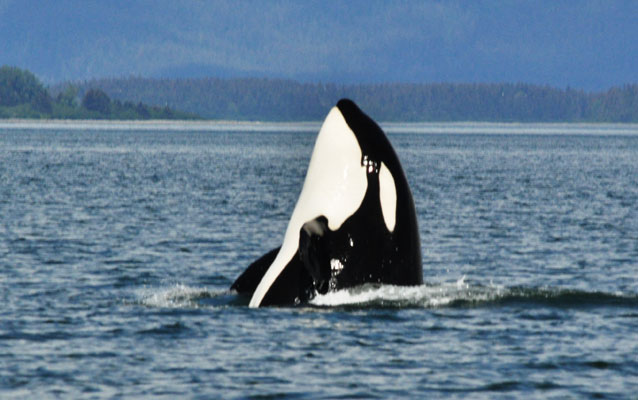Last updated: March 8, 2024
Lesson Plan
Echolocation in Action

- Grade Level:
- Middle School: Sixth Grade through Eighth Grade
- Subject:
- Literacy and Language Arts,Science
- Lesson Duration:
- 60 Minutes
- Common Core Standards:
- 6.RI.7, 6.RI.8, 6.W.2, 6.W.2.a
- Thinking Skills:
- Understanding: Understand the main idea of material heard, viewed, or read. Interpret or summarize the ideas in own words. Applying: Apply an abstract idea in a concrete situation to solve a problem or relate it to a prior experience. Analyzing: Break down a concept or idea into parts and show the relationships among the parts. Creating: Bring together parts (elements, compounds) of knowledge to form a whole and build relationships for NEW situations.
Essential Question
What is echolocation and what role does sound play in an underwater environment?
Objective
*How do marine mammals use sound?
*What are the most common human-made sounds heard in the ocean?
*How might vessel noise affect the behavior (feeding, diving, respiration, resting) of marine mammals?
*Why is studying underwater acoustics important to the survival of marine mammals?
Background
Marine animals rely on sound to acoustically sense their surroundings, communicate, locate food, and protect themselves underwater. Some predators, like orcas (killer whales) and dolphins, use echolocation to find prey. By emitting short pulses of sounds called clicks, these marine mammals listen for echoes to detect prey and navigate around obstacles. Similarly, some fish are able to hear the killer whale clicks and avoid capture! Because these animals live in a relatively dark environment, being able to "see" acoustically is important to their survival. Engineers have mimicked this natural echolocation in SONAR (SOund Navigation And Ranging) which works the same way as echolocation in animals.
Some blind people use sonar by listening to the echoes from taps of their canes to help them avoid objects or help them determine how far they are away from a wall. Sound travels faster and farther underwater than through air. This means that sounds produced by marine animals and humans can travel great distances without much loss to the quality of the sound. These sounds are often reflected by underwater topography making it tricky to communicate using sound underwater. Marine mammals must be able to sort out all the echoes in the water in order to effectively communicate and feed. Whales and dolphin anatomy and sensory systems are adapted to meet this challenge.
While humpback whales do not echolocate, they do use sound to communicate and may use sound to navigate and find food. Glacier Bay is currently studying the effects underwater sound may have on the feeding behavior of endangered humpback whales. Research shows that whales may move away from preferred feeding areas when disturbed by boat noise. Repeated disturbances could be detrimental to Alaskan humpbacks, who must feed enough during the summer to sustain themselves through their 3,000 mile roundtrip migration to and from Hawaii. Additionally, increased ambient noise, or background noise, may make it difficult for humpback whales and other animals to communicate, find mates and more.
Preparation
- Review background information
- Preview video
- Print student materials
Materials
Students use in rounds 1 to 3.
Download Echolocation Worksheet
Worksheet for student use in step 2.
Download Echolocation Bar Graph Worksheet
Lesson Hook/Preview
Do Now: When you hear a strange noise, how do you figure out what it is? Jot down your thoughts in your notebook.
Procedure
Step 1: Engagement
(10 minutes)
Tell students they are going to hone their sense of hearing by using their hands to make "cups." Teach them how to cup their hands around their ears facing forward, then backward. This will help focus sounds to their ears. Tell them it may be useful during the next investigation. Allow them to experiment with their new "ears" by trying to focus on a sound in the room. You can have a student go to the back of the room and clap.
Ask students to carefully listen to several underwater sounds from the clips provided. All of these sounds were recorded using the hydrophone in Glacier Bay. Listen to all six, so students will have the opportunity to discriminate between human-made, animal, and other natural sounds. As you play each clip, have students try to identify the sound source (what is making the sound) and write it in their journals. Ask students to explain experiences they've had with sound underwater.
Underwater sounds recorded in Glacier Bay (click here for a page with audio recordings)
|
Take note of these recordings: Animal Sounds "Glacier Bay humpback whale song November 2020" Vessel Sounds "Cruise Ship Underwater Recording" Other Ambient/Natural Sounds "Heavy Rain on Sea Surface" |
Vocabulary
echolocation, sonar, sound source
Enrichment Activities
Have students compile their data and make comparisons. Create one large chart or bar graph using computer programs like Excel or Word Charts/Graphs. For a more challenging activity, have students plot actual location of snap versus real location and then find the percent of correct responses.
Have students watch the short four-minute video Dean Hudson, acoustic navigator. Dean is visually impaired and uses sound clues to navigate the city. Have several students wear blindfolds or close their eyes while making sound. They can either clap or snap their fingers. See if they can interpret the echoes to navigate around the room without bumping into objects or a wall. Be sure to give them plenty of space and use some students as monitors to help prevent trips or falls.
Additional Resources
Glacier Bay Acoustic Monitoring
Glacier Bay Underwater Acoustics Video
Teach Engineering, resources for K-12 from the University of Colorado.
The Cornell Lab Bioacoustics Research Program
Exploratorium, The Listen Project
